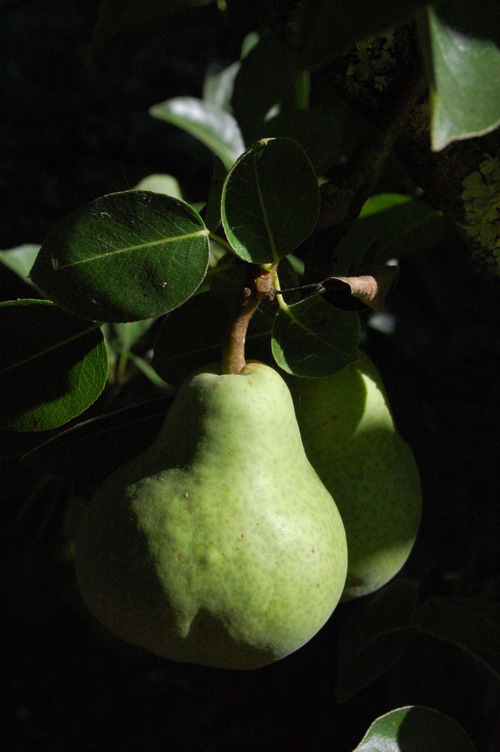Composting, harvest and delicious rewards
By Abby Bard
In the years I’ve been gardening, I’ve learned so much, especially how much I still need to learn. So when I heard about a composting workshop, sponsored by the Daily Acts environmental education group at Sonoma Compost on Mecham Road in Cotati, I signed up.
On the longest day in June, I spent the day at their site to learn the mysteries of composting from Will Bakx, soil scientist and compost master, who runs the facility and conducted the workshop.
Our group started out in a small organic garden, run by and for the employees — the raised beds holding a veritable vegetable jungle, a testament to the fertility of the soils made there — and continued out to the yard, where long rows of shredded vegetation, in various stages of decomposition, are mounded, turned and watered by giant machines and monitored for temperature. This process creates heat, destroys harmful bacteria and kills any seeds, resulting in a healthy, dark, crumbly material that the plants love.
I learned that I’m partway there with my own home composting effort, but could do it a whole lot better. I need to make my pile larger, at least 3’ x 3’ x 3’ in dimension, and:
• Keep the mix of brown materials, like dried leaves, wood chips and shredded newspaper (carbon), and green materials, like pulled weeds and garden waste (nitrogen), at a 30 to 1 ratio
• Reduce particle size
• Buy a long thermometer at the hardware store to keep tabs on the temperature, which should reach 165°
• Keep my pile well-watered, and
• Turn it frequently to move the cooler materials on the outside of the pile into the hot center.
I also learned the differences between hot composting, cold composting (which does not control diseases or weed seeds) and vermicomposting (letting the worms do the work — which is great if you have way more food waste than dried leaves and chipped wood). Christine Condon, who trained at Rudolph Steiner College, taught a segment on Biodynamic composting, a holistic and spiritual approach to composting, increasing the quality of hot-com-posted material by incorporating Biodynamic plant preparations and certified organic animal manures into the mix.
After half a day surrounded by compost, I had a head full of information and the scent of compost and dust in every pore. When the workshop ended, I bought six bags of Sonoma Compost, self-shoveled into recycled potting soil bags that I had brought with me, and came home with enough enthusiasm to mulch my veggie beds with the bagged goods and turn over my own compost pile.
Managing a Bountiful Harvest
I had pulled the garlic, planted last autumn, just before the summer solstice, and was now concerned with curing it properly. Last year’s garlic harvest, to my great disappointment, grew mold inside the cloves. My theory is that I let it sit too long in the sun — the outsides dried, the insides never did, and the mold thrived. This year’s crop of 50-plus bulbs is curing in the garage, spread out on a sheet of cardboard on a table, out of the sun, and out of the damp.
The tomato vines have escaped their cages, dropping ripe fruit everywhere. Autumn figs are turning deep purple and softening on the tree, and apples and pears, both in my own yard and filling the displays at farm stands, farmers’ markets and grocery stores across Sonoma County, are ripe and ready to be transformed into succulent fillings for sweet fruit desserts like my favorite Pear Tart (see recipe, right). The naked ladies have finished blooming, and the sunflowers heads, full of seeds, are pulling the sturdy stalks down to the ground, more signs that summer is over.
Pots of Thai basil, purple basil and big leaf basil, bought as nursery starts in spring, enhanced salads all summer long. I snipped them back when flowers appeared to use in many memorable meals. The plants continued to branch and send out their spicy fragrance for many weeks and are now flowering for the final time as the days grow shorter. I planted more basil in the ground from seed in early summer, sheltered from the harshest sun by spreading tomato vines, and they are showing flower heads as well, so it’s time to make pesto to put away for winter meals.
The Rich Rewards of Home-grown Food
I’ve have had nonstop tomatoes in the garden since the Sungold and Sweet 100s cherry tomatoes began to ripen in May. June was devoted to peaches — canning, freezing, baking and for lots of juicy eating out of hand. I spent much of July and August over the stove and dehydrator in the kitchen, making blackberry and raspberry jams and pear and apple sauces.
Now I’m picking San Marzanos tomatoes off the vines, roasting them with olive oil and garlic into a rich puree to store in the freezer for winter soups and sauces. The sweet Pineapple Tomatoes and dramatic Brandywines are wonderful in end-of-summer salads with fresh mozzarella cheese, ribbons of basil, and drizzles of olive oil and balsamic vinegar. It’s been a glorious summer of growth and learning, and I’m grateful for another harvest.









